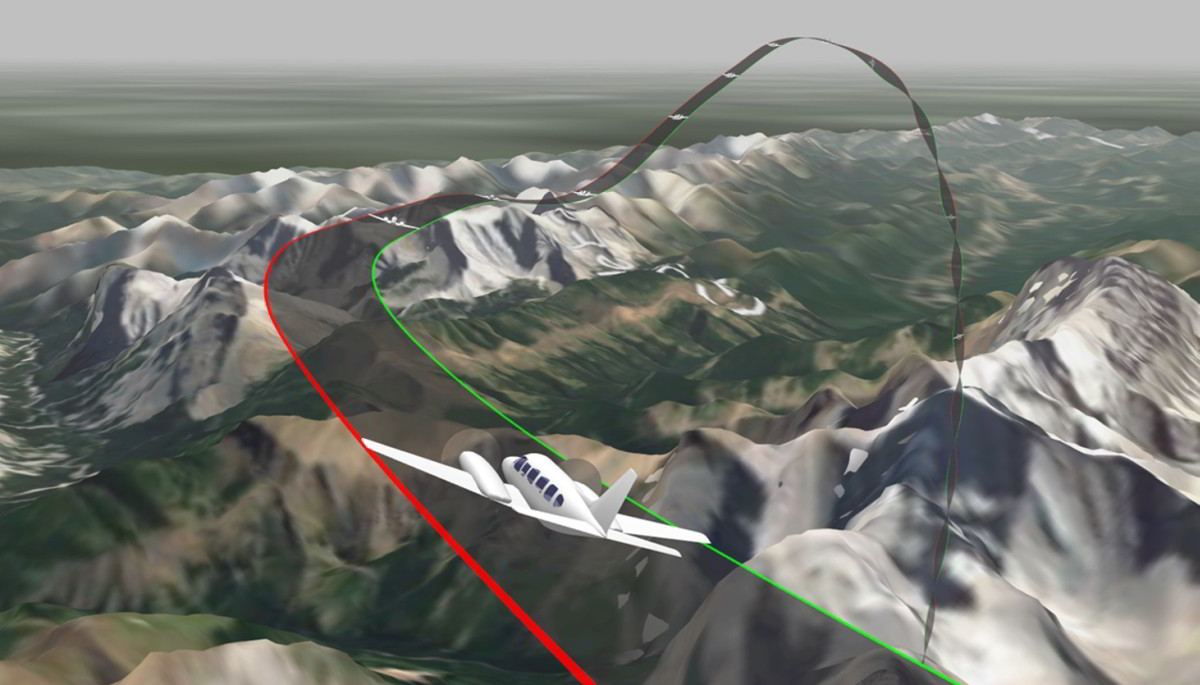Hypoxia indirectly killed the crew of a Canadian survey aircraft, the country’s Transportation Safety Board (TSB) has found in a recent report. The crew of two died when lack of available oxygen at 15,000 ft led to cognitive and performance degradation in the pilot, which caused the aircraft to spin and crash.
A Piper PA-31 Navajo was returning to Calgary Springbank airport in August 2018 after a survey flight when it entered a spin while on initial descent and struck a mountain peak at an altitude of 10,000 ft.
A retrofitted data recorder on the aircraft and a video camera in the cockpit allowed investigators to reconstruct the crash sequence. The pilot showed signs of disorientation three minutes after starting the descent from 15,000 ft, when he read his altitude to ATC rather than airspeed. Soon after, ATC asked the pilot to slow to 150 kt and descend to 13 000 ft. A power reduction was recorded on both engines, but the right reduced more than the left. Airspeed eventually reduced to 71 kt, pitch angle reached 20 degrees nose up at one point and the aircraft entered a spin to the right, to which the pilot responded with inconsistent and incomplete control inputs. The investigation was unable to determine whether the power asymmetry was the result of power-quadrant manipulation by the pilot or an aircraft system malfunction. The aircraft had had a portable crew oxygen system, but the TSB found this was awkward to use, requiring two hands to don the mask, which sat between the pilot’s face and the headset boom microphone. The pilot had not used oxygen continuously during the flight.
Hypoxia is insidious and no respecter of pilot experience or expertise, as Flight Safety Australia found when we investigated it. The TSB’s description of the effects of hypoxia on the pilot is a disquieting paragraph, worth reproducing in full.
‘The pilot likely experienced some degree of hypoxia in this occurrence. Based on the results of controlled research on hypoxia in humans, the investigation concluded that, during the ascent to and continued flight at 15, 000 feet without supplementary oxygen, the occurrence pilot may have experienced headache, dizziness, air hunger, and fatigue, as well as gradual degradations in thinking, memory, judgment, and muscular coordination. His reactions would also have slowed down. His hearing capacity may have started to decrease, and his peripheral vision may have narrowed as the visual field darkened. The pilot may have found it more and more difficult to perform tasks using working memory or to judge airspeed, heading, and orientation. However, due to the slow and gradual onset of symptoms and the probable associated sense of well-being, it is unlikely these effects were noticeable to the pilot.’
The TSB found:
- The pilot did not continuously use oxygen above 13, 000 feet and likely became hypoxic as the aircraft climbed to 15,000 feet. The pilot did not recognise his symptoms or take action to restore his supply of oxygen.
- As a result of hypoxia-related cognitive and perceptual degradations, the pilot was unable to maintain effective control of the aircraft or respond appropriately to the asymmetric power condition.
- The aircraft departed controlled flight and entered a spin to the right because the airspeed was below both the published minimum control speed in the air and the stall speed, and because there was a significant power asymmetry, a high angle of attack and significant asymmetric drag from the windmilling propeller of the right engine.
- When the aircraft exited cloud, the pilot completed only one of the seven spin-recovery steps: reducing the power to idle. As the aircraft continued to descend, the pilot took no further recovery action, except to respond to air traffic control and inform the controller that there was an emergency.
Further information
Oxygen first DVD at CASA Online Store
Flight Safety Australia: back in print
- Flight Safety Australia is available now by subscription from the CASA Online Store for $39.95 for four issues a year, delivered to your door in Australia.
- Subscribe by 25 August to receive the Spring 2019 issue. Subscribers after that date will receive the Summer issue as their first.
- The first 900 subscribers get the gift of a kneeboard, a multitool or a fuel drain (their choice, stocks permitting) with their subscription.
- Subscribe at shop.casa.gov.au



Scary, but totally avoidable! I used to do DSE flying at 10K for hours in the middle of the night, I had a Sat prob set up on one of my fingers with an alarm that told me to O2 up!